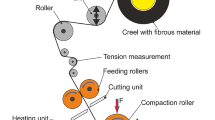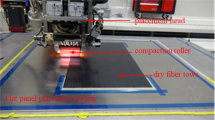Abstract
The laying accuracy of the automated fiber placement (AFP) machine determines the actual laying position of the prepreg tow, which directly affects the mechanical properties of the composite component after curing. The laying accuracy is affected by the coupling of multiple factors such as the spatial movement of the AFP machine, the delivery of the tow, and the coordinated movement of the AFP machine and the tow. Aiming at the problem that the friction conveying accuracy of the tow is difficult to guarantee, the transport model of the tow in the restarting stage is established, and the restarting accuracy of the tow is improved by optimizing the clamping scheme. A timing-based execution method of the restarting and cutting instructions is proposed to meet the process requirements of high placement speed and high coordination precision of the AFP process. Finally, the laying experiments are carried out on a special mold, and the start and end points of the tows can meet the requirements of laying accuracy.


























Similar content being viewed by others
Data availability
The datasets used or analyzed during the current study are available from the corresponding author on reasonable request.
Code availability
The codes used in this study are available from the corresponding author on reasonable request.
References
Gao J, Qu W, Yang D, Zhu W, Ke Y (2021) Two-stage sector partition path planning method for automated fiber placement on complex surfaces. CAD 132:102983. https://doi.org/10.1016/j.cad.2020.102983
Maung PT, Prusty BG, Oromiehie E, Phillips AW, St John NA (2022) Design and manufacture of a shape-adaptive full-scale composite hydrofoil using automated fibre placement. Int J Adv Manuf Technol 123(11):4093–4108. https://doi.org/10.1007/s00170-022-10527-2
Liu F, Zhang W, Shang J, Yi M, Wang S, Ding X (2022) A planar underactuated compaction mechanism with self-adaptability for automated fiber placement heads. Aerospace 9(10):586. https://doi.org/10.3390/aerospace9100586
Woigk W, Hallett SR, Jones MI, Kuhtz M, Hornig A, Gude M (2018) Experimental investigation of the effect of defects in automated fibre placement produced composite laminates. Compos Struct 201:1004–1017. https://doi.org/10.1016/j.compstruct.2018.06.078
Oromiehie E, Prusty BG, Compston P, Rajan G (2019) Automated fibre placement based composite structures: review on the defects, impacts and inspections techniques. Compos Struct 224:110987
Vijayachandran AA, Waas AM (2022) Minimizing stress concentrations using steered fiberpaths and incorporating realistic manufacturing signatures. Int J Non-Linear Mech 146:104160. https://doi.org/10.1016/j.ijnonlinmec.2022.104160
Tang Y, Wang Q, Cheng L, Li J, Ke Y (2022) An in-process inspection method integrating deep learning and classical algorithm for automated fiber placement. Compos Struct 300:116051. https://doi.org/10.1016/j.compstruct.2022.116051
Cheng L, Zhang L, Li J, Ke Y (2021) Modeling and compensation of volumetric errors for a six-axis automated fiber placement machine based on screw theory. Proc Inst Mech Eng C J Mech Eng Sci 235(23):6940–6955. https://doi.org/10.1177/09544062211017163
Cheng L, Zhang L, Li J, Ke Y (2022) Measurement, identification, and compensation of pose errors for six-axis gantry automated fiber placement machine. Int J Adv Manuf Technol 120(3):2259–2276. https://doi.org/10.1007/s00170-021-08373-9
Hamlyn A, Yvan H (2014) Fiber application machine. U.S. Patent 8,733,417, 27 May 2014
Oldani T (2012) Fiber placement machine platform system having interchangeable head and creel assemblies. U.S. Patent 8,151,854, 10 Apr. 2012
Zhao C, Xiao J, Huang W, Huang X, Gu S (2016) Layup quality evaluation of fiber trajectory based on prepreg tow deformability for automated fiber placement. JRPC 35(21):1576–1585. https://doi.org/10.1177/0731684416659933
Xu K, Hao X, Lin J (2022) Automated fibre placement path generation for complex surfaces via digital image deconvolution algorithm. Compos Part A: Appl Sci Manuf 163:107246. https://doi.org/10.1016/j.compositesa.2022.107246
Zhou W, Cheng Q, Xu Q, Zhu W, Ke Y (2021) Deformation and fracture mechanisms of automated fiber placement pre-preg laminates under out-of-plane tensile loading. Compos Struct 255:112948. https://doi.org/10.1016/j.compstruct.2020.112948
Meister S, Wermes M (2022) Performance evaluation of CNN and R-CNN based line by line analysis algorithms for fibre placement defect classification. Prod Eng Res Devel. https://doi.org/10.1007/s11740-022-01162-7
Khan MA, Mitschang P, Schledjewski R (2013) Parametric study on processing parameters and resulting part quality through thermoplastic tape placement process. JCoMa 47(4):485–499
Zhang C, Duan Y, Xiao H, Wang B, Ming Y, Zhu Y, Zhang F (2022) The effects of processing parameters on the wedge peel strength of CF/PEEK laminates manufactured using a laser tape placement process. Int J Adv Manuf Technol 120(11):7251–7262. https://doi.org/10.1007/s00170-022-09181-5
Zhang W, Liu F, Jiang T, Yi M, Chen W, Ding X (2022) Overview of current design and analysis of potential theories for automated fibre placement mechanisms. ChJA 35(4):1–13. https://doi.org/10.1016/j.cja.2021.04.018
Izco L, Isturiz J, Motilva M (2006) High speed tow placement system for complex surfaces with cut/clamp/& restart capabilities at 85 m/min (3350 IPM). Aerosp Manuf Autom Fastening Conf Exhibition. Toulouse, France
Liu F, Zhang W, Xu K, Deng H, Ding X (2018) A planar mechanism with variable topology for automated fiber placement. 2018 Int Conf Reconfigurable Mech Robot (ReMAR), Delft, Netherlands, 2018, pp 1–6. https://doi.org/10.1109/REMAR.2018.8449845
Denkena B, Schmidt C, Weber P (2016) Automated fiber placement head for manufacturing of innovative aerospace stiffening structures. Procedia Manuf 6:96–104
Gordon T, Xu X, Kawashita L, Wisnom MR, Hallett SR, Kim BC (2021) Delamination suppression in tapered unidirectional laminates with multiple ply drops using a tape scarfing technique. Compos Part A: Appl Sci Manuf 150:106627. https://doi.org/10.1016/j.compositesa.2021.106627
Gordon T, Xu X, Wisnom MR, Kim BC (2020) Novel tape termination method for automated fibre placement: cutting characteristics and delamination suppression. Compos Part A: Appl Sci Manuf 137:106023. https://doi.org/10.1016/j.compositesa.2020.106023
DeVlieg R, Jeffries K, Vogeli P (2007) High-speed fiber placement on large complex structures. SAE Aerofast, Los Angeles, California, USA
Cemenska J, (2011) Automating AFP Tuning Using a Laser Sensor, SAE Technical Paper 2011-01-2593. https://doi.org/10.4271/2011-01-2593
Kisch RA (2017) Automated fiber placement compensation. U.S. Patent 9,694,546, 4 Jul. 2017
Dirk H-JL, Ward C, Potter KD (2012) The engineering aspects of automated prepreg layup: history, present and future. Compos B Eng 43(3):997–1009
Mostaghel N, Davis T (1997) Representations of Coulomb friction for dynamic analysis. Earthq Eng Struct Dynam 26(5):541–548
Funding
The authors received financial support from Zhejiang Province Natural Science Foundation (grant no. LQ20E050019), National Natural Science Foundation of China (grant no. 51975520), National Natural Science Foundation of China (grant no. 91948301), and Key Research and Development Program of Zhejiang Province (grant no. 2020C01039).
Author information
Authors and Affiliations
Corresponding author
Ethics declarations
Consent for publication
The authors agree with the publication.
Conflict of interest
The authors declare no competing interests.
Additional information
Publisher's note
Springer Nature remains neutral with regard to jurisdictional claims in published maps and institutional affiliations.
Rights and permissions
Springer Nature or its licensor (e.g. a society or other partner) holds exclusive rights to this article under a publishing agreement with the author(s) or other rightsholder(s); author self-archiving of the accepted manuscript version of this article is solely governed by the terms of such publishing agreement and applicable law.
About this article
Cite this article
Cheng, L., Zhang, L., Zheng, C. et al. Research on the method of improving the laying accuracy of automated fiber placement. Int J Adv Manuf Technol 125, 4883–4897 (2023). https://doi.org/10.1007/s00170-023-10932-1
Received:
Accepted:
Published:
Issue Date:
DOI: https://doi.org/10.1007/s00170-023-10932-1




